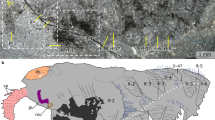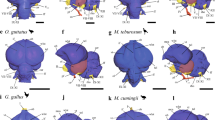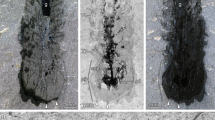Abstract
Arising from P. Cong, X. Ma, X. Hou, G. D. Edgecombe & N. J. Strausfeld Nature 513, 538–542 (2014); doi:10.1038/nature13486
Cong et al.1 report a new anomalocaridid species, Lyrarapax unguispinus, that bears a potential pair of pre-protocerebral ganglia associated with frontal appendages, thus challenging some previous assignments of these appendages to the second (deutocerebral) segment2,3. On the basis of putative similarities in brain anatomy to the extant onychophoran Euperipatoides rowelli, the authors go further by assigning homology between the anomalocaridid-like appendages and the arthropod labrum4. However, we demonstrate that their arguments are based on a misinterpretation of onychophoran neuroanatomy. Consequently, we believe that the proposed affinities of these appendages are incorrect and their homologues remain uncertain. There is a Reply to this Brief Communication Arising by Cong, P. et al. Nature 516, http://dx.doi.org/10.1038/nature13861 (2014).
This is a preview of subscription content, access via your institution
Access options
Subscribe to this journal
Receive 51 print issues and online access
$199.00 per year
only $3.90 per issue
Buy this article
- Purchase on Springer Link
- Instant access to full article PDF
Prices may be subject to local taxes which are calculated during checkout


Similar content being viewed by others
References
Cong, P., Ma, X., Hou, X., Edgecombe, G. D. & Strausfeld, N. J. Brain structure resolves the segmental affinity of anomalocaridid appendages. Nature 513, 538–542 (2014)
Stein, M. A new arthropod from the Early Cambrian of North Greenland, with a ‘great appendage’-like antennula. Zool. J. Linn. Soc. 158, 477–500 (2010)
Haug, J. T., Waloszek, D., Maas, A., Liu, Y. U. & Haug, C. Functional morphology, ontogeny and evolution of mantis shrimp-like predators in the Cambrian. Palaeontology 55, 369–399 (2012)
Budd, G. E. A palaeontological solution to the arthropod head problem. Nature 417, 271–275 (2002)
Schürmann, F. W. in Arthropod Brain, its Evolution, Development, Structure, and Functions (ed. Gupta, A. P. ) Ch. 8 159–180 (John Wiley & Sons, 1987)
Eriksson, B. J., Tait, N. N. & Budd, G. E. Head development in the onychophoran Euperipatoides kanangrensis with particular reference to the central nervous system. J. Morphol. 255, 1–23 (2003)
Strausfeld, N. J., Strausfeld, C., Stowe, S., Rowell, D. & Loesel, R. The organization and evolutionary implications of neuropils and their neurons in the brain of the onychophoran Euperipatoides rowelli. Arthropod Struct. Dev. 35, 169–196 (2006)
Mayer, G., Whitington, P. M., Sunnucks, P. & Pflüger, H.-J. A revision of brain composition in Onychophora (velvet worms) suggests that the tritocerebrum evolved in arthropods. BMC Evol. Biol. 10, 255 (2010)
Whitington, P. M. & Mayer, G. The origins of the arthropod nervous system: Insights from the Onychophora. Arthropod Struct. Dev. 40, 193–209 (2011)
Mayer, G. & Harzsch, S. Immunolocalization of serotonin in Onychophora argues against segmental ganglia being an ancestral feature of arthropods. BMC Evol. Biol. 7, 118 (2007)
Mayer, G. & Koch, M. Ultrastructure and fate of the nephridial anlagen in the antennal segment of Epiperipatus biolleyi (Onychophora, Peripatidae)—evidence for the onychophoran antennae being modified legs. Arthropod Struct. Dev. 34, 471–480 (2005)
Hirth, F. et al. An urbilaterian origin of the tripartite brain: developmental genetic insights from Drosophila. Development 130, 2365–2373 (2003)
Eriksson, B., Samadi, L. & Schmid, A. The expression pattern of the genes engrailed, pax6, otd and six3 with special respect to head and eye development in Euperipatoides kanangrensis Reid 1996 (Onychophora: Peripatopsidae). Dev. Genes Evol. 223, 237–246 (2013)
Sombke, A., Harzsch, S. & Hansson, B. S. Organization of deutocerebral neuropils and olfactory behavior in the centipede Scutigera coleoptrata (Linnaeus, 1758) (Myriapoda: Chilopoda). Chem. Senses 36, 43–61 (2011)
Author information
Authors and Affiliations
Contributions
All authors conceived the project, analysed the material and wrote the paper.
Corresponding author
Ethics declarations
Competing interests
Declared none.
PowerPoint slides
Rights and permissions
About this article
Cite this article
Mayer, G., Martin, C., de Sena Oliveira, I. et al. Latest anomalocaridid affinities challenged. Nature 516, E1–E2 (2014). https://doi.org/10.1038/nature13860
Received:
Accepted:
Published:
Issue Date:
DOI: https://doi.org/10.1038/nature13860
This article is cited by
-
The velvet worm brain unveils homologies and evolutionary novelties across panarthropods
BMC Biology (2022)
-
Brain and eyes of Kerygmachela reveal protocerebral ancestry of the panarthropod head
Nature Communications (2018)
-
Assessing segmental versus non-segmental features in the ventral nervous system of onychophorans (velvet worms)
BMC Evolutionary Biology (2017)
-
The nervous and visual systems of onychophorans and tardigrades: learning about arthropod evolution from their closest relatives
Journal of Comparative Physiology A (2017)
-
Insights into the segmental identity of post-oral commissures and pharyngeal nerves in Onychophora based on retrograde fills
BMC Neuroscience (2015)
Comments
By submitting a comment you agree to abide by our Terms and Community Guidelines. If you find something abusive or that does not comply with our terms or guidelines please flag it as inappropriate.



